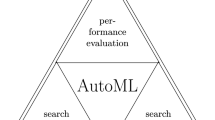Abstract
Feedforward neural networks (FNN) have been proposed to solve complex problems in pattern recognition, classification and function approximation. Despite the general success of learning methods for FNN, such as the backpropagation (BP) algorithm, second-order algorithms, long learning time for convergence remains a problem to be overcome. In this paper, we propose a new hybrid algorithm for a FNN that combines unsupervised training for the hidden neurons (Kohonen algorithm) and supervised training for the output neurons (gradient descent method). Simulation results show the effectiveness of the proposed algorithm compared with other well-known learning methods.
Similar content being viewed by others
References
Rumelhart D.E., Hinton G.E. Williams R.J. (1986) Learning internal representations by error propagation, Parallel Distributed Processing: Explorations in the Microstructures of Cognition, Vol 1. MIT Press, Cambridge MA, pp. 318–362
Lera G., Pinzolas M., (2002) Neighborhood Based Levenberg-Marquardt Algorithm for Neural Network Training. IEEE Transactions on Neural Networks 13(5): 1200–1203
Silva F., Almeida L., (1990) Speeding-Up Backpropagation. In: Eckmiller R. (ed), Advanced Neural Computers. North-Holland, Amsterdam, pp. 151–156
Scalero R.S., Tepedelenlioglu N., (1992), A fast algorithm for training feedforward neural networks. IEEE Transactions on Signal Processing 40(1): 202–210
Fahlman S.E.: Faster learning variations on back propagation, An Empirical Study, In: Proceedings of the 1988 Connectionist Models Summer School, pp. 38–51, Carnegie Mellon University.
Rojas R., (1996) Neural Networks : A Systematic Introduction. Springer-Verlag, Berlin
Jacobs R.A. (1988), Increased rates of convergence through learning rate adaptation. Neural Networks 1: 295–307
Najim K.,, Chtourou M., Thibault J. (1992), Neural network synthesis using learning automata. Journal of Systems Engineering 2(4): 192–197
Poznyak A.S., Najim K., Chtourou M. (1993), Use of recursive stochastic algorithm for neural network synthesis. Applied Math Modelling 17: 444–448
Nickolai S.R. (2000), The layer-wise method and the backpropagation hybrid approch to learning a feedforward neural network. IEEE Transactions on Neural Networks 11(2): 295–305
Abid S., Fnaiech F., Najim M. (2001), A fast feedforward training algorithm using a modified form of the standard backpropagation algorithm. IEEE Transactions on Neural Networks 12(2): 424–430
Oscar F.R., Deniz E., Jose C.P.: Accelerating the convergence speed of neural networks learning methods using least squares, In: Proceedings of the ESANN’2003, pp. 255–260, Belgium, 2003
Bilski J. (2005), The UD RLS algorithm for training feedforward neural networks, Internat. Journal of Applied Mathematical Computer Science 15(1): 115–123
Liu P., Li H. (2004), Efficient learning algorithms for three-layer regular feedforward fuzzy neural networks. IEEE Transactions on Neural Networks 15(3): 545–558
Bortoletti A., Di FIore C., Fanelli S., Zellini P. (2003), A new class of Quasi-Newtonian methods for optimal learning in MLP-networks. IEEE Transactions on Neural Networks 14(2): 263–273
Hornik K., Stinchcombe M., White H. (1989), Multilayer feedforward networks are universal approximators. Neural Networks 2: 359–366
Kohonen T. (1990), The self-organizing map. Proceedings of the IEEE 78(9): 1464–1480
Azimi-Sadjadi I.M.R., Liou R.J. (1992), Fast learning process of multilayer neural nets using recursive least squares method. IEEE Transactions on Signal Processing 40(2): 443–446
Alexander G.P., Benito F., Amir F.A., Jayakumar M., Wei K.T. (1994), An accelerated learning algorithm for multilayer networks. IEEE Transactions on Neural Networks 5(3): 493–497
Mackey M.C., Class L. (1977), Oscillation and chaos in physiological control system. Sience 197: 287–289
Author information
Authors and Affiliations
Corresponding author
Rights and permissions
About this article
Cite this article
Nasr, M.B., Chtourou, M. A Hybrid Training Algorithm for Feedforward Neural Networks. Neural Process Lett 24, 107–117 (2006). https://doi.org/10.1007/s11063-006-9013-x
Published:
Issue Date:
DOI: https://doi.org/10.1007/s11063-006-9013-x




